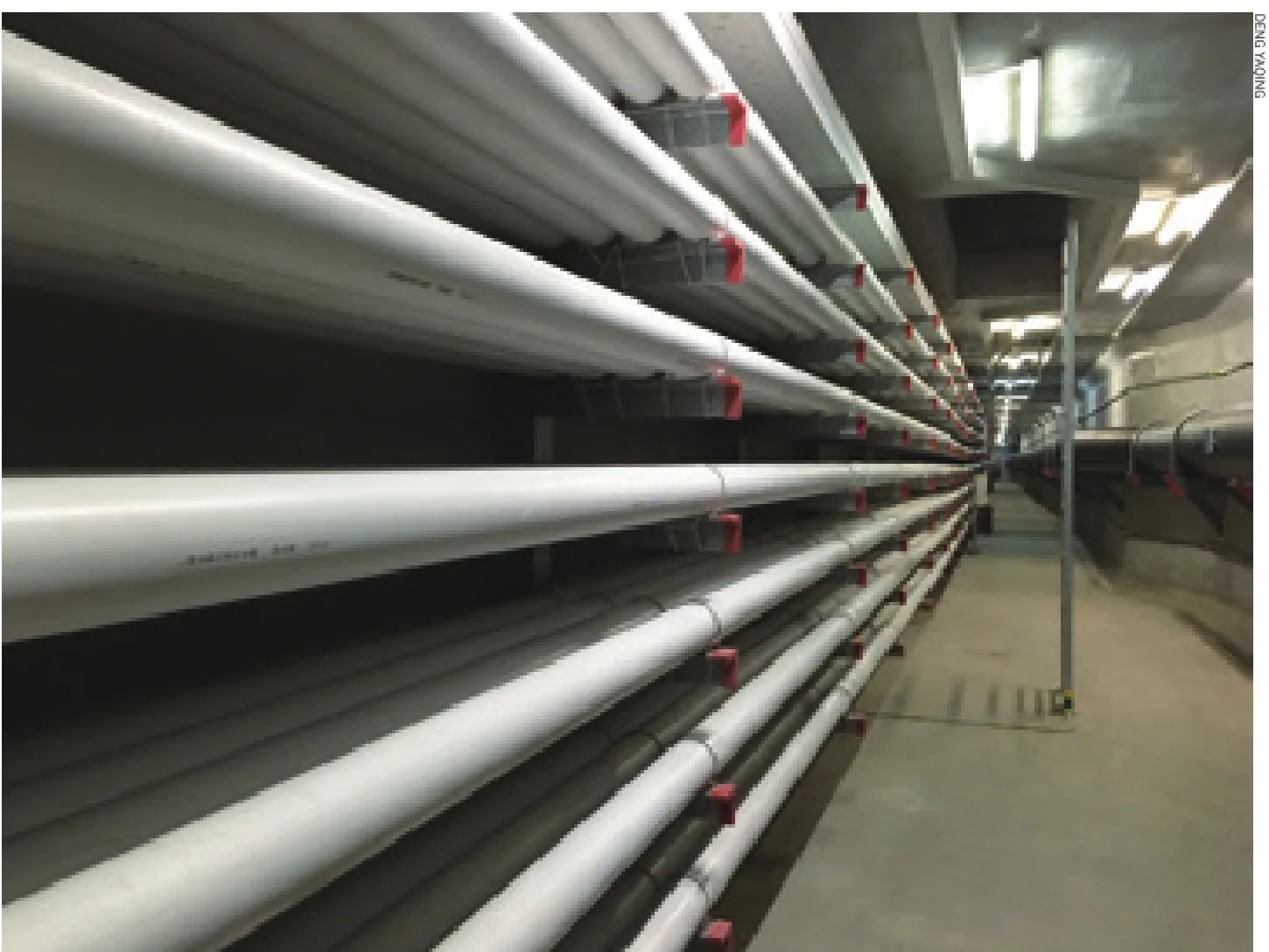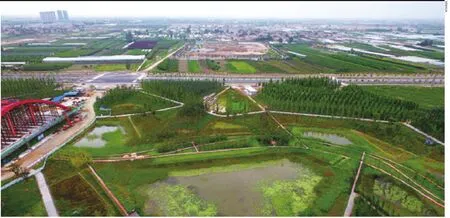Soaking up A Precious Resource
2016-09-26DengYaqing
Soaking up A Precious Resource
New construction aims to harness rainwater and put an end to urban flooding By Deng Yaqing

Underground pipelines in Hengqin of Zhuhai, south China’s Guangdong Province
Frequently visited by strong rainstorms this summer, many cities in south China have been overwhelmed with rainwater. Cars floating across intersections,students boating to school and some people robbed of their lives by flood water—scenes such as these have stirred the hearts of people across the nation accustomed to living in concrete jungles cut off from nature.
As urbanization continues to progress in China, an urban design concept—sponge city—has gradually gained attention. Just as the description implies, such a city can absorb, store and recycle 70 percent of rainfall, effectively filter pollutants from rainwater and reduce the rainfall runoff that directly flows into drainage systems.
“Now, many cities face an awkward situation. When it’s rainy, these cities are troubled by waterlogging, because the drainage system is overwhelmed. When the flood water recedes, they quickly fall into drought,” said Zhou Qiguo, Vice General Manager of WISDRI Engineering & Research Corp. Ltd.
According to a survey conducted by the Ministry of Housing and Urban-Rural Development (MOHURD) in 2010, 213 cities—62 percent of the 351 cities surveyed across the country—had suffered flooding at some point since 2008, 137 of which had experienced flooding at least three times.
In December 2013, at the Central Urbanization Work Conference, President Xi Jinping first proposed the building of sponge cities featuring natural storage, natural permeation and natural purification. In November 2014, the MOHURD promulgated guidelines on the construction of sponge cities. Shortly afterward, 16 cities were designated as the first batch of sponge cities in a pilot program, and in April this year, the program was extended to include 14 more cities.
“As a brand new urban planning and design idea, a sponge city can facilitate the utilization of rainwater resources and eliminate problems like waterlogging through a series of links; filtration, retention, storage,purification, utilization and drainage,” said Chen Xiongzhi, chief engineer of the Wuhan Urban & Rural Construction Committee’s Municipal Engineering Department.
Retaining water
Wuhan, capital of central China’s Hubei Province, is a populous city embellished by thousands of lakes and rivers. It was severely hit by seven days of persistent rain from June 30 to July 6. Along the local Tangxu River,numerous residential communities and villas were soaked in water for days. One place, however, escaped inundation: the WISDRI headquarters. The 26.67-hectare base integrates an array of sponge technologies and measures, such as a parking lot paved with water-permeable bricks.
“Building a sponge city is a systematic project and should be realized by combining the natural environment with artificial measures. Therefore, cost varies with different local conditions,” said WISDRI’s vice general manager Zhou, who suggested that the incremental cost of sponge city construction can be controlled below 5 percent.
In actual fact, sponge city construction can not only improve the quality of life, but also protect people’s lives and property to a large extent. Besides, remarkable improvements canbe gained in air circulation, soil, vegetation and humidity, generating great environmental effects, said Zhou.
The government should not measure the value of a project just by calculating how much money it can make in the short term, because as long as people’s lives and property are better protected, the project can be deemed worthwhile, said Ye Chun, vice head of the Sponge City Institute at the Metallurgical Corp. of China Ltd. (MCC).
Though sponge city construction should be promoted nationwide, despite its moderate cost and tremendous benefit, the process of dissemination and replication is fraught with difficulties and challenges.
“First of all, the government needs to coordinate the construction work in different parts of a city. For example, if the ground elevation of several adjacent districts is not reasonably coordinated and planned, rainwater still can’t drain away even if sponge engineering measures are fully applied,” said Zhou, who emphasized top-level design and integration.
Aside from that, the sponge city concept should be incorporated into urban planning,design and construction, rather than being talked about separately, because it’s quite hard to transform a traditional city into a sponge one,Zhou noted.
For the reconstruction of old cities, measures should be adjusted to local conditions.“When building a sponge city, consideration should be given to local conditions, which can be quite diverse. At the same time, a set of universal standards should be formulated. Local governments can make some adjustments to them and evaluate sponge city projects,” said Zhou.

A 6.9-km greenbelt is located in the center of Fengxi New City—a pilot sponge city—in Xi’an, capital of northwest China’s Shaanxi Province
Draining water
While sponge city design and construction can facilitate the absorption and storage of up to 70 percent of rainfall runoff, the remaining 30 percent should drain away via a network of pipes running through purposebuilt tunnels, or galleries. Built several meters underground, the galleries, which are large enough to allow maintenance access, obviate the need to repeatedly excavate streets either to lay new pipes or to mend or replace old ones. Besides water pipes, power supply conduits and cables as well as communications links can also be routed through the dedicated tunnels, technically known as“integrated pipeline galleries.” Furthermore,automatic monitoring and control systems can be installed, so that maintenance workers can be rapidly alerted to deal with any problems that occur.
The 33.4-km integrated pipeline project in Hengqin, an island within the city of Zhuhai in south China’s Guangdong Province, is the most advanced of its kind in China. “Integrated pipeline galleries are urgently needed, especially in developed areas, because they can save land,” said Wang Zhenzhi, Vice General Manager of China MCC20 Group Corp. Ltd., a subsidiary of MCC that built the Hengqin project.
Wang said the project saved roughly 400,000 square meters of land, since all the various types of underground pipe and cable are concentrated in specific, planned channels rather than being spread out randomly. Assuming the land price was 20,000 yuan($3,000) per square meter, the project saved the local government 6 billion yuan ($900 million) after deducting the 2-billion-yuan($300-million) construction cost.
“It not just reduces land use, but also prolongs the service life of pipelines, which are more prone to corrosion when buried in soil,”said Wang.
However, since China started constructing underground pipeline galleries relatively late, the country lags behind developed nations such as Japan and Germany in this area.
“Objectively speaking, [closing] the major gap between China and the developed world in building integrated pipeline galleries … [requires] the popularization of the concept and the improvement of legislation,” Li Yuefei, an expert from Capital Engineering and Research Corp. Ltd., told Beijing Review. The second major gap lies in ideas about urban planning. City managers need to replace their outdated management philosophy and catch up with development trends in planning and design philosophy, he added.
“Beyond that, China should close its gap with developed countries in construction quality, operations and maintenance and give more consideration to long-term benefit,” Li suggested. ■
Copyedited by Chris Surtees
Comments to dengyaqing@bjreview.com
